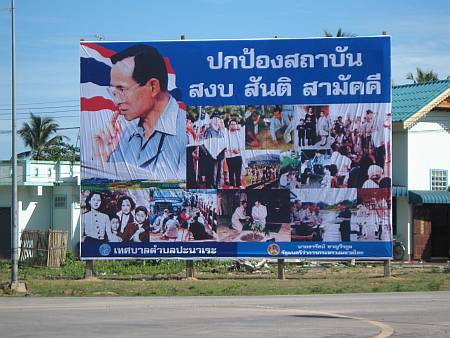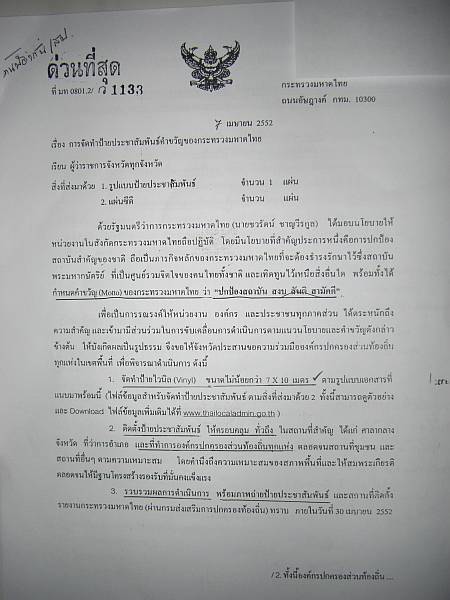In a recent essay questioning Prime Minister Abhisit’s claim that things have “returned to normal” in Thailand following the suppression of the April red shirt rising, Kevin Hewison (Asia Sentinel, 4 June 2009) refers briefly to state-promoted signboards that have flooded Thailand’s landscape. Here I’d like to build on that important observation more closely.
Since late April this year a new sign has sprouted on roadsides and intersections throughout the country. It features a montage of photographs of the king from various periods of his reign, with a larger portrait at the top left backed by the Thai national flag. These pictures are set on a dark blue background and feature a two line injunction:
PROTECT THE INSTITUTION (ie. Monarchy): CALM-PEACE-SOLIDARITY
On the bottom right is the emblem of the Ministry of the Interior, and on the left the name of the tambon organization or municipality in whose boundaries the sign has been erected. In some areas the Ministry of Interior emblem is not shown (but more on that later).
The Ministry of Interior Billboard (click on the image for a larger version)
The question arises: why is an injunction to “protect” the monarchy required in a county where devotion to the king is so universal? Note that the widely-denigrated red shirts made a point of solemnly standing to sing the national anthem at their rallies in April and declare devotion to the king.
There are at least two answers to this question: first, the sign symbolically demonizes the red shirts and other opponents of the government by signalling that any turbulence (ie. khwam mai sangop) – which is by definition a violation of the virtue of “calm” (sangop) – is a disloyal act.
Second, it refects the agenda of the Bhumjai Thai party (formed last January and controlled by the “Friends of Newin” faction) to build its legitimacy with the anti-Thaksin Democrat-led government, which it helped to form after deserting the Pheua Thai Party. The Minister of the Interior is Chawarat Charnwirakul, former PPP minister, “Friends of Newin” faction members, and leader of the Bhumjai Thai Party. Control of the powerful Interior Ministry gives the Bhumjai Thai Party considerable clout, and it has exercised it to the full.
It is hardly a coincidence that the slogan on the new billboards is the same as the one printed on the tee-shirts of the so-called “blue-shirts” who opposed red shirt anti-government demonstrators in Pattaya during April, and who shot two red-shirt supporters, killing one, on 11 April. Blue tee-shirts emblazoned with the slogan were produced and distributed by Ministry of Interior officials to local people in Pattaya and were also worn by some police from the northeastern provinces, who were mobilized by the Deputy Interior Minister Boonjong Wongtrairat (also of Bhumjai Thai and the “Friends of Newin” faction) from his political heartland to confront red-shirt demonstrators at Pattaya. When queried by journalists about the distribution of these shirts, Boonjong stressed that blue was the colour of the monarchy, and denied that the shirts were used to advertise his party, whose colour is also blue.
The deliberate blurring of the boundaries between the Bhumjai Thai Party and the state are clear in the operations of the Ministry of the Interior. It was recently shown in the “seminar” staged at the edge of a constituency of the northeastern province of Sakhon Nakhon last week, during the campaign for the critical by-election where Bhumjai Thai and Pheua Thai were competing. Chawarat used his power as minister during his campaign visit to the province to summon the governor of Sakhon Nakhon to attend, ostensibly to listen to discussion about “government policy.”
Clearly nothing has changed in the political uses of the Interior Ministry – it was harnessed by the Democrats when they held the portfolio in the late 1990s, and by Thaksin’s Thai Rak Thai government. Now it is being used by the Bhumjai Thai party to undermine is political opponents. This suits the Democrat Party, since it shares a common enemy in the red shirts, but it also shows how much leeway the Bhumjai Thai party is being granted, clearly because the Democrats depend on this party and its de facto taskmaster Newin Chidchop, for the survival of their increasingly shaky coalition government.
Thanks to a friend who is nayok (mayor) of a municipal tambon, I recently obtained a copy of the orders sent by the Ministry of Interior to erect these billboards. The details are rather interesting. Stamped as “most urgent” the letter of instruction was sent to all province governors, and from thence transmitted to all local government bodies in each province. Of particular note is the fact that the order from the Minister of the Interior to erect the billboards is dated 7 April. This is the same day that Newin Chidchop made his tearful speech to journalists, where he appealed to his former boss to stop “damaging the monarchy,” and professed his devotion to the king. Is the convergence of these two dates a coincidence? I think not. Both the Ministry of Interior order and Newin’s choreographed announcement were a clear reaction to the red shirt anti-government demonstration in Bangkok, which began 12 days earlier, on 26 March.
The order begins by outlining that it follows an important “policy” laid down by Chawarat as Minister of Interior for all bodies under the control of the Ministry of Interior to follow. In the weighty language of the centralized state, highlighting the indivisibility of the country and its bureaucracy, the letter goes on to point out that: “It is the principal duty of the Ministry of the Interior to protect the institution of the monarchy that is at centre of the collective soul of the Thai people throughout the country and venerated in numerous ways.” Following this imperative duty the Ministry of Interior has determined a “motto,” namely: “Protect the Institution – Calm -Peace-Solidarity.” It continues:
This is a campaign for all working units, organizations and the population generally to be conscious of the motto and to participate and follow the direction of this policy. In order to make this tangible [the Ministry of Interior] requests that provinces arrange for the cooperation of all local government organizations everywhere in their areas.
There follows specification of the size of the “public relations sign,” to be printed by each local government body according to the template provided on a CD disk supplied with the letter. The size of billboards is specified to be no smaller than 7 x 10 metres, and local government organizations are instructed to erect them in prominent locations throughout their areas by 30 April at the latest. Each local government body was required to pay for these billboards from their own budgets.
The Ministry of Interior orders (click on the image for a larger version)
Most municipalities and tambon organizations seem to have erected their signs fairly soon after 20 April. But some were not particularly happy about it, not the least because the expenses amounted to over 10,000 baht. My friend the mayor (from a southern Thai Buddhist-majority province) objected to the sign, both because of the expense involved and because he viewed it disapprovingly as politically motivated. Though a southerner (frequently stereotyped as Democrat supporters) he is in fact a former Thai Rak Thai supporter, and was highly critical of the government suppression of the red-shirt movement in early April. Like all local government executives, however, he cannot refuse the order of the Ministry. What he did do, however, was restrict the number of billboards to one only, and he instructed the printers to omit the logo of the Ministry from the poster – “why should I advertise for the Ministry when we are paying for the billboard” he explained. This was a strange form of resistance, but it was all he could do under the circumstances.
Popular reactions to this conspicuous billboard in the red-shirt strongholds of the northeast have been negative. As a red shirt from Udon Thani (a middle-ranking district-level public servant) pointed out to me: “Most people are unhappy with this billboard. The king and the monarchy are deep in the peoples’ hearts already – they know that the Ministry of the Interior is controlled by Bhumjai Thai Party and that they are playing politics by invoking the royal institution.”
Given this reaction, it appears that this Ministry of Interior “campaign” has succeeded only in demonstrating the formal power of the Ministry to command province, district and sub-district government bodies. Of course, that coercive power is significant, and exposes the fiction of decentralization in Thailand. But the policy does not seem to have stimulated the desired response in the key areas where it was targeted. On 21 June the Bhumjai Thai party, armed with all the bureaucratic resources at its command, failed miserably in its effort to wrest control of the Sakhon Nakhon constituency from the Pheua Tai Party and its red-shirt supporters.
 Facebook
Facebook  Twitter
Twitter  Soundcloud
Soundcloud  Youtube
Youtube  Rss
Rss 
